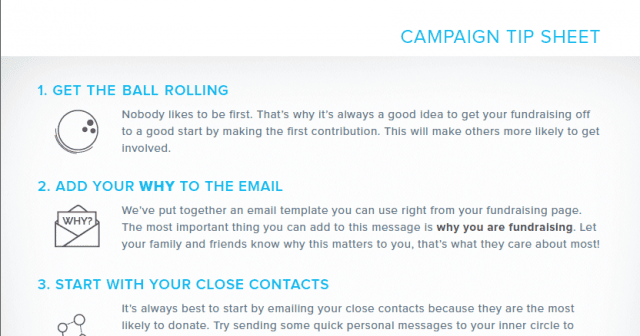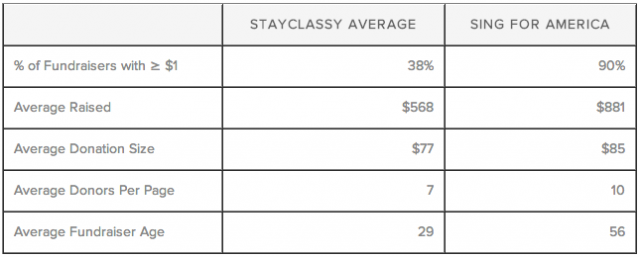From Peer-to-Peer Fundraising Zero to Hero in One Read

Request a Demo
Learn how top nonprofits use Classy to power their fundraising.
If you’ve never launched a peer-to-peer fundraising campaign before, it might seem pretty daunting. You might be unsure of where to even start, or whether you’ll have the resources to make it successful. You may feel like you’re starting from zero. And we know that can feel scary.
If you feel this way, you might be one of the following types of organizations who have never tried peer-to-peer fundraising before, and are wondering how to get started. We’ve come up with three scenarios, along with direction and guidance for each one, on peer-to-peer fundraising. We want you to see that these campaigns are a great way to build community and sustain revenue. Best of all, you can do it anytime.
Organization A: We are a younger organization and want to start peer-to-peer fundraising, but we’re worried our donor base is too small to fundraise effectively, or to bring in a substantial number of new supporters.
Actually, you’re in a perfect place to start peer-to-peer fundraising! One of the key aspects of peer-to-peer is its ability to grow your list of contacts and increase donations in a short amount of time. Because you’re tapping into your network’s networks, you are able to reach a lot more people with peer-to-peer fundraising than you can with direct messaging. And the best part is that you don’t need a long list of preexisting contacts to start leveraging it as a tool for donor acquisition. All you need to get started is a small, core group of supporters.
Our platform data has shown that the average active fundraising page brings in 7 donors and raises $568. That means if fifteen people create fundraising pages, you would raise $8,520 and bring in 105 donors on average! If you want to go the extra mile to get the ball rolling for those first fundraisers, you can create fundraising pages for them, with well thought out appeals and with all the appropriate branding.
The point is that with even just a small number of active supporters, you can use peer-to-peer fundraising to exponentially increase donations and bring new supporters into the fold.
In addition to your targeted campaign or events, adopt a year-round fundraising program to continuously bring in donors. Having this permanent, year-round option on your site gives supporters new opportunities. For example, they can transform their birthdays, anniversaries, or athletic milestones into fundraising opportunities for your cause. This allows you to continuously bring in new supporters and produce revenue, even when you’re not running a targeted campaign.
Organization B: We have some supporters and are launching our first peer-to-peer campaign, but we have no idea where to start.
Start with planning
First and foremost, your plan of action should be to break your campaign into smaller, manageable sections. Creating a timetable of specific milestones will make it a lot easier to achieve your overall campaign goals. While we’ve found a 4-phase campaign to be effective, you can start planning out smaller campaign benchmarks by asking yourself:
- How many people can I get to create fundraising pages, and by when?
- How many inactive fundraisers (ones who haven’t raised any money) can I get to become active fundraisers (ones who have raised at least $1), and by when?
- At what point do I shift my focus from recruiting potential fundraisers to helping active fundraisers reach their goals?
Start with ensuring your fundraisers can be successful
Before you launch your campaign, prepare campaign collateral, like videos, photos, impact stories, and an onboarding e-mail series. While these are important, it’s vital that you take the time to prepare a specific type of material: resources for your fundraisers. Because your fundraisers are the ones doing the asking, you want to set them up for success.
One organization’s experiment found that between two groups of fundraisers, the group that received a fundraising tips sheet raised over three times the amount than the group that didn’t receive a guide. This powerfully demonstrates the importance of educating your fundraisers and equipping them with the tools they need to achieve success.
A few resources you can prepare are social media posts, email appeals, and design resources for their personal fundraising pages. You can even create a fundraising tips sheet of your own to help your supporters gear up for success. As your campaign progresses, work with your supporters to develop their own, individualized strategy for reaching their fundraising goal.
This will not only impact your campaign’s bottom line, but will also deepen the relationship you have with your fundraisers.

Organization C: We just had an event and want to keep excitement and engagement high. How do we use peer-to-peer fundraising to build off its momentum?
The great thing about peer-to-peer fundraising is that you can leverage it anytime. It works well even after, before, or during an event to continuously engage supporters. This also means you don’t have to wait until your next seasonal campaign or event to raise money. By having a permanent year-round fundraising option on your website, you can cultivate a community that fundraises independently for your organization all year round. And because this allows supporters to advocate for your cause when they want, and how they want, it becomes a vehicle for self-expression that can reinforce and deepen their support for your organization.
That being said, the key to keeping engagement high after an event is to immediately provide supporters with other opportunities to get involved, especially ones they can manage on their own. One way you can do this is by cross-promoting other independent year-round fundraising options at your events.
If you run a silent auction or black-tie event, you can have programs outlining these opportunities. If you’re hosting a 5K run or walk, you can inform participants onsite about your rolling peer-to-peer program, which enables them to fundraise for your organization anytime they choose to run any race. No matter what kind of event you host, the goal is to let your supporters know that they can take action for your organization outside of your organized events.
Tip: When your next event rolls around, you incorporate peer-to-peer fundraising to offset overhead costs. Instead of a registration fee, you can ask attendees to raise a certain amount to gain entrance into the event. This combined registration and fundraising method can help you increase donations and engage your supporters on another level.
Organization D: Our supporter base has traditionally been older, but we want to use peer-to-peer to also connect with younger supporters.
A large part of peer-to-peer’s appeal to younger supporters is the individualization of their connection to a cause. Millennials are empowered to share their own stories, as it relates to yours, on their personal fundraising pages. In addition, this type of social fundraising allows them to see how their individual goals fit into the overarching purpose of a larger community.
To engage Millennials, begin by promoting a common purpose shared by other people. Make it easy to see the collective goal. How many dollars you want to raise? What are you fundraising for? How many others are participating? Real-time feeds are a great way to transparently demonstrate these facets of your campaign, whether they show your campaign’s overall fundraising progress or the profiles of other participants. The main idea is to communicate your progress and how your community achieves success together.
Millennials aren’t the only ones that can fundraise online, by the way. Other generations of supporters can fundraise just as effectively as tech-savvy Millennials. Take Sing 4 America as an example. They launched a successful campaign that mobilized 90 percent of their fundraising community, and the average fundraiser age was 56-years-old.

No matter what age, everyone can be incredibly effective fundraisers and members of your online community. As with all supporters, they just might need the right encouragement and assistance. Reach out to them and cater to their needs, like setting up pages or building email templates.
You can also leverage your older donor base to reach their younger contacts and bring them into the fold. For example, older supporters can lead to networks with their younger family members and friends are active.
Keep in mind that peer-to-peer campaigns run in concert. So, it’s important to see how each one feeds into your fundraising cycle. And because your nonprofit can leverage it anytime, for a breadth of occasions, you can experiment and test what approach and communication strategies are most effective for your organization. All you need to do to start reaping the benefits of peer-to-peer is to just, well, try it!

Create a Year-Round P2P Fundraising Machine
Subscribe to the Classy Blog
Get the latest fundraising tips, trends, and ideas in your inbox.
Thank you for subscribing
You signed up for emails from Classy
Request a Demo
Learn how top nonprofits use Classy to power their fundraising.
 Explore Classy.org
Explore Classy.org 

